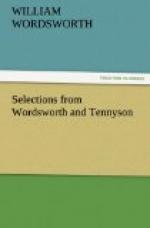“Nay, nay,” said Hall,
“Why take the style of those heroic
times?
For nature brings not back the Mastodon,
Nor we those times; and why should any
man
Remodel models? these twelve books of
mine
Were faint Homeric echoes, nothing-worth,”
. . .
Critics have agreed for the most part in considering the Morte d’Arthur as the most Homeric of Tennyson’s poems. Bayne writes: “Not only in the language is it Homeric, but in the design and manner of treatment. The concentration of interest on the hero, the absence of all modernism in the way of love, story or passion painting, the martial clearness, terseness, brevity of the narrative, with definite specification, at the same time, are exquisitely true to the Homeric pattern.” Brimley notes, with probably greater precision, that: “They are rather Virgilian than Homeric echoes; elaborate and stately, not naive and eager to tell their story; rich in pictorial detail; carefully studied; conscious of their own art; more anxious for beauty of workmanship than interest of action.”
It has frequently been pointed out in this book how prone Tennyson is to regard all his subjects from the modern point of view:
a truth
Looks freshest in the fashion of the day.
The Epic and the epilogue strongly emphasize this modernity in the varied modern types of character which they represent, with their diverse opinions upon contemporary topics. “As to the epilogue,” writes Mr. Brooke (p. 130), “it illustrates all I have been saying about Tennyson’s method with subjects drawn from Greek or romantic times. He filled and sustained those subjects with thoughts which were as modern as they were ancient. While he placed his readers in Camelot, Ithaca, or Ida, he made them feel also that they were standing in London, Oxford, or an English woodland. When the Morte d’Arthur is finished, the hearer of it sits rapt. There were ‘modern touches here and there,’ he says, and when he sleeps he dreams of
“King Arthur, like a modern gentleman
Of stateliest port; and all the people
cried,
‘Arthur is come again, he cannot
die.’
Then those that stood upon the hills behind
Repeated—’Come again,
and thrice as fair:’
And, further inland, voices echoed—’Come
With all good things and war shall be
no more.
“The old tale, thus modernised in an epilogue, does not lose its dignity, for now the recoming of Arthur is the recoming of Christ in a wider and fairer Christianity. We feel here how the new movement of religion and theology had sent its full and exciting wave into Tennyson. Arthur’s death in the battle and the mist is the death of a form of Christianity which, exhausted, died in doubt and darkness. His advent as a modern gentleman is the coming of a brighter and more loving Christ into the hearts of men. For so ends the epilogue. When the voices cry, ’Come again, with all good things,’




